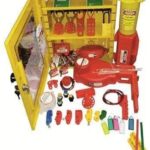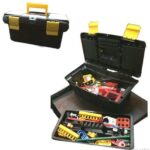Your list is empty, add products to the list to send a request
How Do You Test a Fire Alarm System?

16
Aug
A fire alarm is one of the most important safety features in any building. But having one installed isn’t enough—it must be tested regularly to ensure it works when you need it most. Learning how to test a fire alarm system properly helps you stay compliant with fire safety regulations, avoid fines, and most importantly, protect lives.
Testing doesn’t have to be complicated. By following a structured procedure, you can confirm that every detector, panel, and sounder is doing its job. In this guide, we’ll cover how to test a fire alarm system step by step, the tools you’ll need, and the standards you should follow.
Why You Must Test a Fire Alarm System Regularly
Fire alarms save lives—but only if they function properly.
Here’s why testing matters:
- Life safety: Ensures early warning in case of fire.
- Legal compliance: Fire codes such as BS 5839 and NFPA 72 require routine testing.
- Reduced downtime: Detects faults before they cause major failures.
- Insurance validity: Many insurers demand proof of regular testing.
Even a high-quality panel like the Ravel RE-9016 Conventional Fire Alarm Panel – 16 Zones should be tested routinely to ensure ongoing reliability.
Preparing to Test a Fire Alarm System
Before testing, you need a plan. Testing a system without preparation can disrupt operations or cause unnecessary panic.
Steps to prepare:
- Notify building occupants – Prevents confusion and panic.
- Inform the monitoring centre – If your system is connected to a central station, avoid triggering false emergency calls.
- Review manufacturer instructions – Different panels, like the Ravel fire panel, may have unique procedures.
- Have tools ready – Smoke test aerosols, call point keys, and multimeters.
- Check the logbook – Record all results for compliance.
How to Test a Fire Alarm System: Step-by-Step
Now, let’s walk through the actual testing process.
1. Test the Fire Alarm Control Panel
- Check LED indicators, power supply, and display messages.
- Ensure no fault or trouble signals are present.
- Confirm the panel is receiving backup power.
2. Test Manual Call Points (Break Glass Units)
- Use a test key to simulate activation.
- Verify that the panel recognises the zone and triggers the alarm.
- Reset after testing.
3. Test Smoke Detectors
- Use smoke aerosol spray to simulate fire.
- Confirm the detector sends a signal to the panel.
- Check if sounders activate immediately.
4. Test Heat Detectors
- Apply a heat detector tester (controlled heat source).
- Ensure proper signal transmission to the panel.
5. Test Sounders and Visual Alarms
- Verify that alarms are audible and visible throughout the building.
- Walk around to confirm there are no dead zones.
6. Test Battery Backup
- Disconnect mains power.
- Check if the system continues running on backup batteries.
7. Reset the System
- After all tests, reset the panel.
- Ensure no alarms or fault conditions remain.
How Often Should You Test a Fire Alarm System?
Regulations recommend different testing intervals:
- Weekly – Test one manual call point each week.
- Monthly – Check panel functions, power supplies, and visual indicators.
- Quarterly – Inspect detectors, sounders, and notification devices.
- Annually – Full system inspection by a certified fire safety engineer.
Following this routine ensures maximum reliability and compliance.
Testing a Fire Alarm System in Commercial vs Residential Buildings
The testing frequency may vary depending on the type of property.
- Commercial buildings – Require strict weekly and monthly testing to meet fire code standards.
- Residential complexes – Regular checks of detectors and panels ensure tenant safety.
- High-risk facilities (factories, hospitals, warehouses) – Often demand more frequent inspections due to higher hazards.
Common Issues Found During Testing
When you test a fire alarm system, you might encounter:
- Faulty detectors (dust, age, or wiring issues)
- Low battery warnings
- Silent sounders or weak alarms
- Communication errors between panel and devices
- False alarms due to environmental factors
Catching these issues early prevents system failures in emergencies.
Why Choose Ravel Fire Panels for Reliable Testing
The Ravel fire panel range is designed for easier, more reliable testing.
Key benefits include:
- Clear zone indication, making it simple to identify test results
- User-friendly controls for activation and reset
- Built-in diagnostics to detect faults quickly
- Compatibility with a wide range of detectors and call points
Explore the Ravel RE-9016 Fire Alarm Panel for dependable fire safety management.
Frequently Asked Questions
1. How to test the fire alarm system?
To test a fire alarm system, check the control panel, activate manual call points, simulate smoke or heat at detectors, confirm alarm sounders, and verify battery backup. Always document results.
2. What is the fire system test procedure?
The test procedure involves:
- Informing occupants and monitoring stations
- Testing detectors, call points, alarms, and backup power
- Recording outcomes in a logbook
- Resetting the system after testing
3. Should a fire alarm system be tested?
Yes. Testing is legally required and essential for safety. A system that isn’t tested may fail during a real fire, putting lives and property at risk.
Final Thoughts & Call to Action
Testing your fire alarm system is not optional—it’s a legal and moral responsibility. A system that isn’t regularly checked may fail when lives depend on it most.
By learning how to test a fire alarm system properly and investing in reliable equipment like the Ravel fire panel, you ensure your property remains safe, compliant, and protected.
Ready to upgrade or replace your fire alarm panel? Explore the Ravel RE-9016 Conventional Fire Alarm Panel today and speak with our team for expert installation support.



























